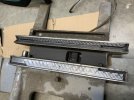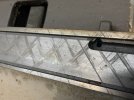Correct, someone (amateurishly) put oil retention marks (er… scars on that one) on it. There’s no apparent scraping evident. A negative is there appears to be scoring running horizontally on a short section laterally to indicate possible heavy use in the middle area, which is common. You won’t know if it’s “good” until you set it up and properly set your chuck on it and indicate, and then truly put in the time to learn the nuance of wheels—coolant-technique-grinding. But it’s pleasurable. What is “good” is up to you. “Function reasonably” - for? I understand knife making but ideally/theoretically w a hard used surface grinder, strive for .0001” or thereabouts across your chosen ground piece on such used machinery.
Apology if you already know, most manual grinders are a pandora-ish box of indications needed and proper chuck setup (and skimmed flat and to your machine) to ensure it’s optimal. You can chase your tail around trying to get it right unless you really lean into the basics and then some should it not run “very flat” from the get-go. And getting a great grind finish is a whole other topic.
When you lay it back on and put it together and properly tighten your magnetic chuck on it (one nut torqued other looser but tightened), start testing the travel w a proper quality one-ten-thou or .0005” indicator. Years ago when I bought my dirty used ‘50’s manual Butterfly/Sanford type, it ran .013” across! Nuts! (I didn’t test-indicate it in the back of a dark dirty home when I took the chance to buy it, not that it mattered since it could take about an hour or two to set one up properly to best determine its capability.)
Took me six months of odd weekends w a proper large granite for scraping and bluing to hand-scrape it to produce .0003” variance across about 12”, which was just about “good enough” for my use. There is a lot to setup and technique to get good flatness - another wonderful skill set. Read all you can about these grinders and hand scraping if you need to, and how to refine that to best your machine ways and travel. Good luck!!




